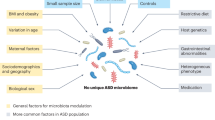Abstract
Recent anecdotal reports have touted the gastrointestinal (GI) hormone secretin as a treatment modality for autism, though there is little clinical evidence or literature to support its viability. We undertook a two-part clinical trial to investigate these claims. Fifty-six patients (49 boys, 7 girls, mean age = 6.4 years, SD = 2.7) enrolled in an open-label trial of secretin, during which they received one injection of the hormone (2 IU/kg). All subjects were evaluated by their parents at baseline and follow-up visits (3–6 weeks later, M = 3.7, SD = 1.4 weeks) with Childhood Autism Rating Scales (CARS). Thirty-four patients were labeled with Pervasive Developmental Disorder Not Otherwise Specified, and 22 met diagnostic criteria for Autistic Disorder. Forty-five patients were concurrently on other drug treatments. At follow-up, some reported minimal but potentially significant improvements including changes in GI symptoms, expressive and/or receptive language function, and improved awareness and social interactions. No adverse effects were reported or observed. Subsequently, 17 of the most responsive patients from Study 1 began a double-blind trial that also included 8 newly enrolled patients. Patients in this second study were alternatively entered into one of two groups and received injections of secretin or placebo with crossover at 4 weeks. Patients from Study 1 entered into Study 2 at an average of 6.5 (SD = 0.8) weeks after beginning Study 1. Results of both inquiries indicate that although treatment with secretin was reported to cause transient changes in speech and behavior in some children, overall it produced few clinically meaningful changes when compared to children given placebo injections.
Similar content being viewed by others
REFERENCES
American Psychiatric Association. (1994). Diagnostic and statistical manual of mental disorders (4th ed.) Washington, DC: Author.
Bardenstein, R., Chez, M. G., Helfand, B. T., Buchanan, C. P., & Zucker, M. (1998). Improvement in EEG and clinical function in pervasive developmental delay (PDD): Effect of valproic Acid. Neurology, 50, A86.
Chez, M. G., & Buchanan, C. P. (1996). Clinical spectrum of patients referred for Landau-Kleffner syndrome previously diagnosed with pervasive developmental delay or autism: EEG, HMPAO SPECT, and steroid response data. Neurology, 46, A115.
Chez, M. G., & Buchanan, C. P. (1997). Age of regression of language and behavior in children referred for pervasive developmental delay correlates with severity of epileptiform activity on 24-hour EEG. Epilepsia, 38, 50.
Chez, M., Buchanan, C., Zucker, M., & May, B. (1997). Value of 24 hour EEG versus routine EEG in detecting occult epileptiform activity in children with pervasive developmental delay. Annals of Neurology, 42, 509.
Chez, M. G., Buchanan, C. P., Field-Chez, M., Loeffel, M. F., & Hammer, M. S. (1998). Treatment of electroencephalographic epileptiform activity on overnight EEG studies in children with pervasive developmental disorder or autism: Defining similarities to the Landau-Kleffner syndrome. Journal of Developmental and Learning Disorders, 2, 217–229.
Chez, M., Buchanan, C., Loeffel, M., Field-Chez, M., Nowinski, C., Bardenstein, R., Hammer, M. (1998). Practical treatment with pulse dose corticosteroids in pervasive developmental delay or autistic patients with abnormal epileptiform sleep EEG and language delay. In M. V. Perat (Ed.), New developments in child neorology (pp. 695–698). Bologna, Italy: Monduzzi Editore.
Chez, M. G., Loeffel, M., & Buchanan, C. (1998). Pulse high-dose steroids as combination therapy with valproic acid in epileptic aphasia patients with pervasive developmental delay or autism. Annals of Neurology, 44, 539.
Chugani, D. C., Muzik, O., Behen, M., Rothermel, R., Janisse, J. J., Lee, J., & Chugani, H. T. (1999). Developmental changes in brain serotonin synthesis capacity in autistic and nonautistic children. Annals of Neurology, 45, 287–295.
Happé, F., & Frith, U. (1991). Is Autism a pervasive developmental disorder? How useful is the “PDD” label. Journal of Child Psychology and Psychiatry, 32, 1167–1168.
Horvath, K., Stefanatos, G., Sokolski, K. N., Watchel, R., Nabors, L., & Tildon, J. T. (1998). Improved social and language skills after secretin administration in patients with autistic spectrum disorders. Journal of the Association for Academic Minority Physicians, 9, 9–15.
Kienle, G. S., & Keine, H. (1996). Placebo effect and placebo concept: a critical methodological and conceptual analysis of reports on the magnitude of the placebo effect. Alternative Therapies in Health Medicine, 2 (6, 39–54)
Maris, E. (1998). Covariance adjustment vs. gain scores-revisited. Psychological Methods, 3, 309–327.
Montgomery, G. H., & Kirsch, I. (1997). Classical conditioning and the placebo effect. Pain, 72, 107–113.
Perry, R., & Bangaru, B. S. (1998). Secretin and autism. Journal of Child and Adolescent Psychopharmacology, 8, 247–248.
Plioplys, A. V. (1994). Autism: Electroencephalogram abnormalities and clinical improvement with valproic acid. Archives of Pediatric and Adolescent Medicine, 148, 220–222.
Schopler, E., Reichler, R. J., & Renner, B. R. (1988). The Childhood Autism Rating Scale: CARS. Los Angeles, CA: Western Psychological Sciences.
Stefanatos, G. A., Grover, W., & Geller, E. (1995). Case study: Corticosteroid treatment of language regression in pervasive developmental disorder. Journal of the American Academy of Child and Adolescent Psychiatry, 34, 1107–1111.
Trauner, D. A., Nabangchng, C., Ballantyne, A., & Tecoma, E. (1997). Developmental aphasia with epileptiform abnormalities on EEG: Clinical features and response to prednisone. Annals of Neurology, 42, 465.
Volkmar, F. R., & Nelson, D. S. (1990), Seizure disorders in autism. Journal of the American Academy of Child and Adolescent Psychiatry, 29, 127–129.




